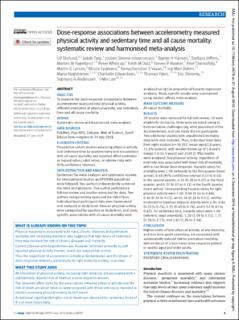| dc.description.abstract | Objective: To examine the dose-response associations between accelerometer assessed total physical activity, different intensities of physical activity, and sedentary time and all cause mortality.
Design: Systematic review and harmonised meta-analysis.
Data sources: PubMed, PsycINFO, Embase, Web of Science, Sport Discus from inception to 31 July 2018.
Eligibility criteria: Prospective cohort studies assessing physical activity and sedentary time by accelerometry and associations with all cause mortality and reported effect estimates as hazard ratios, odds ratios, or relative risks with 95% confidence intervals.
Data extraction and analysis: Guidelines for meta-analyses and systematic reviews for observational studies and PRISMA guidelines were followed. Two authors independently screened the titles and abstracts. One author performed a full text review and another extracted the data. Two authors independently assessed the risk of bias. Individual level participant data were harmonised and analysed at study level. Data on physical activity were categorised by quarters at study level, and study specific associations with all cause mortality were analysed using Cox proportional hazards regression analyses. Study specific results were summarised using random effects meta-analysis.
Main outcome measure: All cause mortality.
Results: 39 studies were retrieved for full text review; 10 were eligible for inclusion, three were excluded owing to harmonisation challenges (eg, wrist placement of the accelerometer), and one study did not participate. Two additional studies with unpublished mortality data were also included. Thus, individual level data from eight studies (n=36 383; mean age 62.6 years; 72.8% women), with median follow-up of 5.8 years (range 3.0-14.5 years) and 2149 (5.9%) deaths were analysed. Any physical activity, regardless of intensity, was associated with lower risk of mortality, with a non-linear dose-response. Hazards ratios for mortality were 1.00 (referent) in the first quarter (least active), 0.48 (95% confidence interval 0.43 to 0.54) in the second quarter, 0.34 (0.26 to 0.45) in the third quarter, and 0.27 (0.23 to 0.32) in the fourth quarter (most active). Corresponding hazards ratios for light physical activity were 1.00, 0.60 (0.54 to 0.68), 0.44 (0.38 to 0.51), and 0.38 (0.28 to 0.51), and for moderate-to-vigorous physical activity were 1.00, 0.64 (0.55 to 0.74), 0.55 (0.40 to 0.74), and 0.52 (0.43 to 0.61). For sedentary time, hazards ratios were 1.00 (referent; least sedentary), 1.28 (1.09 to 1.51), 1.71 (1.36 to 2.15), and 2.63 (1.94 to 3.56).
Conclusion: Higher levels of total physical activity, at any intensity, and less time spent sedentary, are associated with substantially reduced risk for premature mortality, with evidence of a non-linear dose-response pattern in middle aged and older adults. | |
